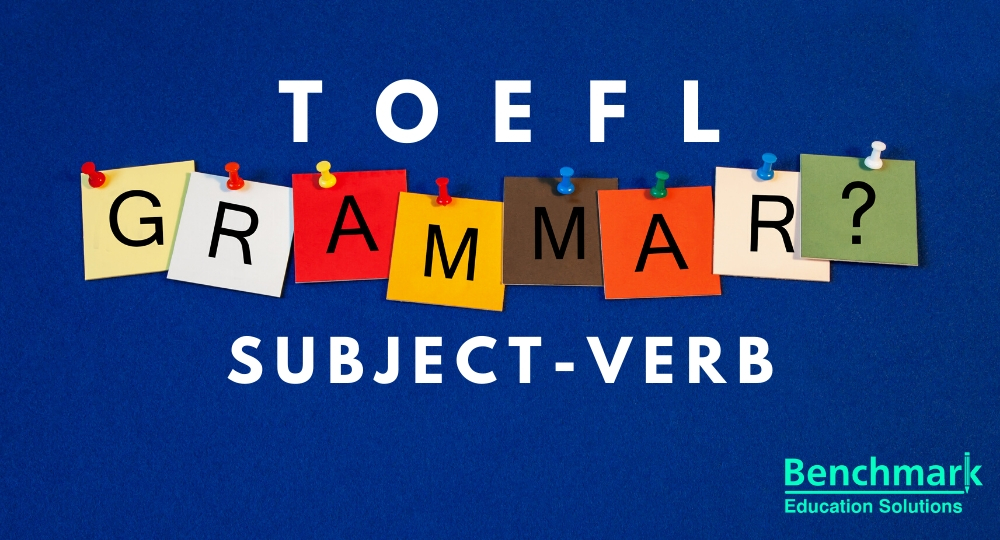Mastering Subject and Verb for a Great TOEFL Score


In order to get a high score for TOEFL, you will need to be good at grammar. That doesn’t mean necessarily knowing all the rules of English grammar, but it does require you to have a mastery over the absolute basics. While it is possible to make some small mistakes in your test and still get a good score, you should not be making fundamental errors.
One of the most basics parts of the English language is the subject and verb of a sentence. In fact, this could be said to be the most important part of English, and without it there simply wouldn’t be any sentences at all.
In today’s grammar lesson, I’m going to explain some important things about subjects and verbs so that you can stand a better chance of avoiding errors and impressing your TOEFL examiner.
Does every sentence need a subject and verb?
The answer to this question is pretty much “yes.” There are a few exceptions, but most of these occur in formal English. It is sometimes possible to give a one word sentence like “Hello,” or “Yes,” or “No.” There are also some informal constructions like “See you later” that imply a subject but don’t actually feature it. However, few of these would help you in your TOEFL writing test. For that, you will need to use academic language.
In academic English, a sentence needs three things: 1) a subject, 2) a verb, and 3) a complete thought. There could be other things in those sentences, but at minimum it needs those three things. If even one of them is missing, we call this a “sentence fragment,” and that is considered a big mistake in grammar. Sentence fragments will stick out for an examiner, and you would certainly be penalized.
Look at this sentence:
- I run.
It contains a subject (I) and a verb (run). This is technically a complete thought because it contains nothing that requires anything else to explain it. Even though there is not a lot of information, this is a complete sentence and it is grammatically correct. However, I wouldn’t recommend you write a two word sentence for TOEFL…
Instead, for TOEFL and for general everyday English, we tend to use the subject and verb of a sentence to build upon by adding extra information:
- I run twice a week because I want to keep fit.
You can see that there is much more detail to this sentence. There are also now two subjects and three verbs! It perhaps makes it easier to look at the sentence in terms of clauses:
Main clause: I run twice a week
Dependent clause: because I want to keep fit.
The first clause still has the same subject and verb, but it now has a few extra words that provide more detail about how often I run. The second one has a subject (I) and a verb (want) and another verb (keep). However, that second verb is part of a phrase that acts as an object. We are mostly interested in the main verb of the clause.
Finding verbs and subjects
When you are reading or listening to something in English, it’s important to focus on subjects and verbs because these usually convey the most information. Certainly, they are often the most important part of a sentence.
Finding a subject usually means looking to the beginning of a sentence, but a better way is to find the verb and see what is doing it. First, though, that means finding the verb…
A verb is a word that usually describes an action or a state of being. It can be modified according to the time when it happened or how many people or things are doing it. Look at the following sentence and find the verb:
- Last week, Sarah asked me an interesting question.
The verb here is “asked.” This is the verb “ask” but in its past simple form. We can easily look at the verb and then tell who did the asking: Sarah. So Sarah is the subject and “asked” is the verb.
Remember that verbs are not always very active, like “kick” or “run.” They also indicate states of being, and so “to be” is a verb.
What about the following sentence?
- All of the children in the current kindergarten class will be in university by the time there’s another eclipse like that.
This is harder to figure out, right?
The verb here is “will be,” which is the future simple form of “to be.”
So what, then, is the subject?
The subject is: “All of the children in the current kindergarten class.” That’s right: sometimes a subject can be a noun phrase, which is a group of words that functions as a subject in place of a single word noun.
Mistakes with subjects and verbs
If you really want to do well at TOEFL, then you will need to avoid common mistakes with subjects and verbs. By far, the biggest problem in that regard is the issue of subject-verb disagreement. This means that the subject and verb of a sentence (or clause) are in the wrong form relating to the number of the subject.
Another way of putting that is if the subject is plural (ie there is more than one thing) and the verb is matched to a singular subject, then this is an error. It’s an easy mistake to make, but it sounds really bad to native speakers. A TOEFL examiner would not be able to overlook this sort of mistake, and so it would definitely affect your score.
Take a look at this sentence:
- The trees outside my window blows back and forth in the night.
What is the problem here?
Well, let’s look to find the subject and verb first. The verb is “blows” and the subject is “trees.” Perhaps you can already see the problem.
In English, a singular noun usually requires a verb with an “s” at the end of it, while a plural one doesn’t. Here, there is more than one tree, so we need to say “trees… blow…” If it was just one, we would say “tree… blows…” However, you cannot say “trees… blows…”
Conclusion
If you want to get a good score for TOEFL, it is imperative that you get good at grammar. The first step toward boosting your grammar to acceptable levels is mastering subject and verb. This isn’t too difficult, but it definitely requires practice. You should work on finding a verb in a sentence and then looking to see where they subject is. When you are making your own sentences for speaking or writing, you need to pay close attention to whether they are in the right form or not. Over time, you will get better at this and it will become second nature.






